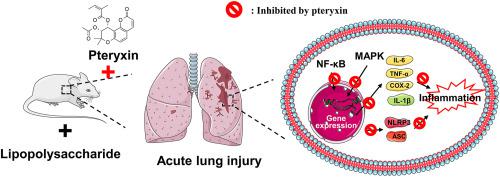Journal of Ethnopharmacology ( IF 4.8 ) Pub Date : 2021-12-21 , DOI: 10.1016/j.jep.2021.114924 Tian-Qi Xuan 1 , Guohua Gong 2 , Huanhuan Du 1 , Chunyan Liu 1 , Yun Wu 3 , Guilan Bao 1 , Qianqian Ma 1 , Dong Zhen 1

|
Ethnopharmacological relevance
Peucedanum praeruptorum seed root is a common medicinal herb with antipyretic, expectorant, antitussive, and therapeutic effects against bronchitis and furuncle. The roots of this herb contain many coumarin compounds, including pteryxin.
Aim of this study
To investigate whether pteryxin can alleviate the LPS-induced lung injury and the mechanism involved.
Material and methods
Male BALB/C mice were orally given sodium carboxymethylcellulose (CMC-Na) (0.5%, 1mL/100g) and pteryxin (suspended in CMC-Na; 0.5%) at 5, 10, 25 mg/kg once daily for 7 days. Subsequently, the mice received a single intratracheal instillation of 5 mg/kg LPS or saline as the control. After 8 hours, the mice were sacrificed to collect bronchoalveolar lavage fluid (BALF) and lung tissues. These samples were used to determine the lung W/D (wet/dry) weight ratio, total protein (TP) levels, inflammatory cytokines (IL-6, TNF-α, and IL-1β) and expression of protein involved in MAPK/NF-κB pathway and NLRP3 inflammasome. H&E staining was carried out on tissue sections to explore the pathological alterations induced by LPS. The protein expression of F4/80 and NLRP3 in lung tissues was analyzed using immunohistochemical staining. The binding of pteryxin to target proteins (MAPK, NF-κB and NLRP3) was determined based on molecular docking tests.
Results
Treatment with pteryxin reduced the lung W/D weight ratio, total protein (TP) level and levels of inflammatory cytokines (TNFα, IL-6 and IL-1 β) significantly. Therefore, it ameliorated LPS-induced inflammatory response in BALB/C mice. Moreover, pteryxin suppressed LPS-induced upregulation of proteins involved in MAPK/NF-κB signaling pathway and NLRP3 inflammasome activation. The expression level of F4/80 and NLRP3 was also downregulated by pteryxin pretreatment in lung tissues. Docking analysis revealed that pteryxin bound to target proteins (MAPK, NF- κB and NLRP3) with a fit-well pattern .
Conclusion
Pteryxin may attenuate LPS-induced acute lung injury by dampening MAPK/NF-κB signaling and NLRP 3 inflammasome activation.
中文翻译:

翼霉素通过调节 MAPK/NF-κB 通路和 NLRP3 炎性体激活对 LPS 诱导的急性肺损伤的保护作用
民族药理学相关性
前胡种子根是一种常见的药材,具有解热、祛痰、镇咳、治疗支气管炎、疔疮等作用。这种草本植物的根部含有许多香豆素化合物,包括翼翅目。
本研究的目的
探讨翼霉素是否能减轻LPS诱导的肺损伤及其作用机制。
材料与方法
雄性 BALB/C 小鼠口服羧甲基纤维素钠 (CMC-Na) (0.5%, 1mL/100g) 和 pteryxin (悬浮在 CMC-Na; 0.5%) 5, 10, 25 mg/kg,每天一次,持续 7 天。随后,小鼠接受单次气管内滴注 5 mg/kg LPS 或盐水作为对照。8小时后,处死小鼠以收集支气管肺泡灌洗液(BALF)和肺组织。这些样本用于测定肺 W/D(湿/干)重量比、总蛋白(TP)水平、炎性细胞因子(IL-6、TNF-α 和 IL-1β)和参与 MAPK/ NF-κB 通路和 NLRP3 炎性体。对组织切片进行H&E染色以探索LPS诱导的病理改变。使用免疫组织化学染色分析肺组织中F4/80和NLRP3的蛋白表达。
结果
用翼霉素治疗显着降低了肺 W/D 重量比、总蛋白 (TP) 水平和炎性细胞因子 (TNFα、IL-6 和 IL-1 β) 的水平。因此,它改善了 BALB/C 小鼠中 LPS 诱导的炎症反应。此外,pteryxin 抑制 LPS 诱导的参与 MAPK/NF-κB 信号通路和 NLRP3 炎性体激活的蛋白质的上调。F4/80 和 NLRP3 的表达水平也被 pteryxin 预处理在肺组织中下调。对接分析显示,pteryxin 与靶蛋白(MAPK、NF-κB 和 NLRP3)具有良好的结合模式。
结论
Pteryxin 可通过抑制 MAPK/NF-κB 信号传导和 NLRP 3 炎性体激活来减轻 LPS 诱导的急性肺损伤。






























 京公网安备 11010802027423号
京公网安备 11010802027423号